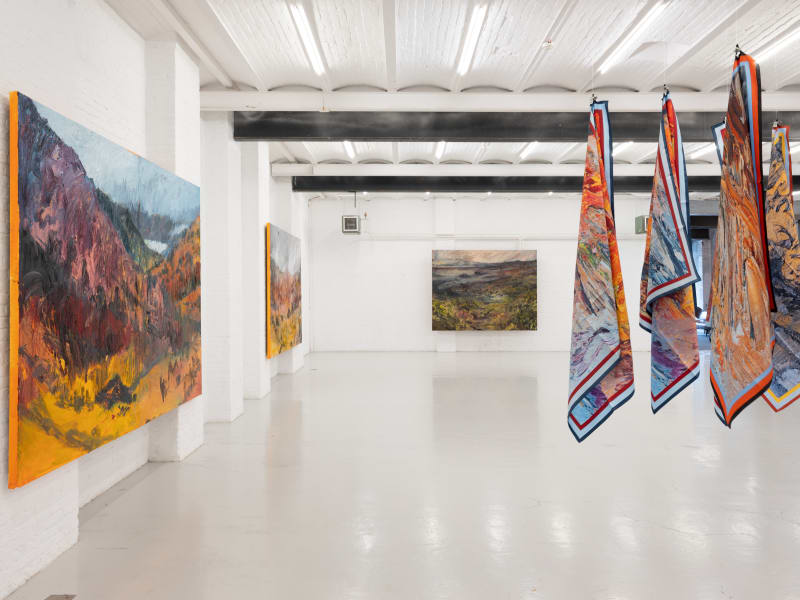In the spring of 2024, Nils Verkaeren travelled to the Isle of Skye — a place that seems less discovered than encountered — following an invitation from Arlette Van Oost, founder of SCAPA. Decades earlier, Van Oost had found her own origin story in the Orkney Islands, where, after a plane malfunction, she witnessed women weaving wool against the North Sea winds. That image — of raw material, human labour, and elemental force — became the silent blueprint of her fashion house.
Now, in a different medium but with shared intuition, a painter enters similar weather, carrying not wool but canvas and oil. Not to capture a view, but to inhabit it.
“I’m not a landscape painter,” says Verkaeren. “But I do work in the landscape — and often, it works on me.”
What may sound like a paradox is, in fact, a guiding principle. Verkaeren does not go outside to paint what he sees, but to let events imprint themselves. Observation gives way to absorption. The canvas becomes a site of tension — between intent and interference, between what is willed and what arrives uninvited. On the Isle of Skye, that tension was relentless. Winds shifted hourly, tides arrived without warning, hail tore through wet paint.
“You can see the storm in the skin of the painting,” he says.
“The paint thickens. It tears. It drips. Sometimes it simply refuses to move.”
These are not expressive effects — they’re meteorological facts, recorded in pigment.
Verkaeren’s practice does not seek out landscape as motif. Instead, he explores what painting becomes when it’s no longer protected — when the artist is vulnerable to cold, shifting skies and the rough geometry of land split by wind. Each work is marked by decisions made under pressure: to persist, adjust, or surrender.
“You constantly have to decide,” he says. “Do I hold on to what I was doing, or let the new conditions in?”
This question — and its repetition — reshapes the painting each time.
This is not a romantic plein-air revival. His process owes less to Impressionism than to a lineage concerned with risk, instability, and physical engagement over time. He knows the references — from Constable’s clouds to Eardley’s sea-battered surfaces, from Monet’s fugitive light to Auerbach’s thick revisions — but he doesn’t quote them. His work remains contemporary in its unease, its resistance to resolution, its openness to change.
What matters is the event of painting — that suspended space between intention and impact. Verkaeren paints from inside the moment, not after it. His works hold a strange clarity: structured, yet disrupted. Exact, but never fixed.
“I like it when things go wrong,” he says.
“It forces me to paint differently — more directly, more honestly. Less about vision, more about reaction.”
Throughout his career, Verkaeren has sought out environments that unsettle the act of painting. Not for spectacle, but for confrontation.
In Tidal Flux (Knokke, 2022), sea levels determined tempo. In the Colombian jungle, resin outpaced control. In a sealed glass container in Puurs, oil fumes altered perception. In each case, the process grew from a shifting rapport with place — responsive rather than premeditated.
The Skye series continues this ethos but brings a new slowness. As winter receded and spring cautiously arrived, the air opened — and so did the paintings. What began in weight and struggle gave way to softness, breath, and moments of quiet. Works like Held Breath, Turning Quiet, or The Middle Distance do not depict landscapes in any traditional sense. They are documents of presence — of staying still inside something that resists stillness.
The work does not abstract from the landscape; it abstracts through it. Not by reducing what is seen, but by enduring what unfolds. This produces a truth that is less visual than tactile. You don’t just see Skye — you feel how it pressed back. The drag of drying paint in cold air, the sudden shift of colour when the sun returns — these physical responses are inscribed in the surface. They become topographies of process: the tide retreating before the paint dried, the hand adjusting because a cloud moved.
Asked about abstraction, Verkaeren replies:
“What you see always comes later.”
That delay — between sensation and recognition — is essential. His works don’t depict; they displace. They refuse to stabilise the land into image. Abstraction here is not a style, but a consequence. It emerges because the world won’t stay still.


